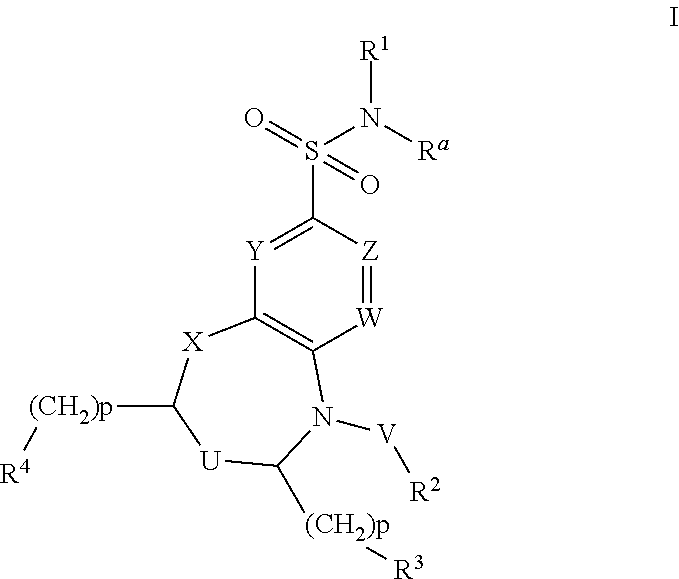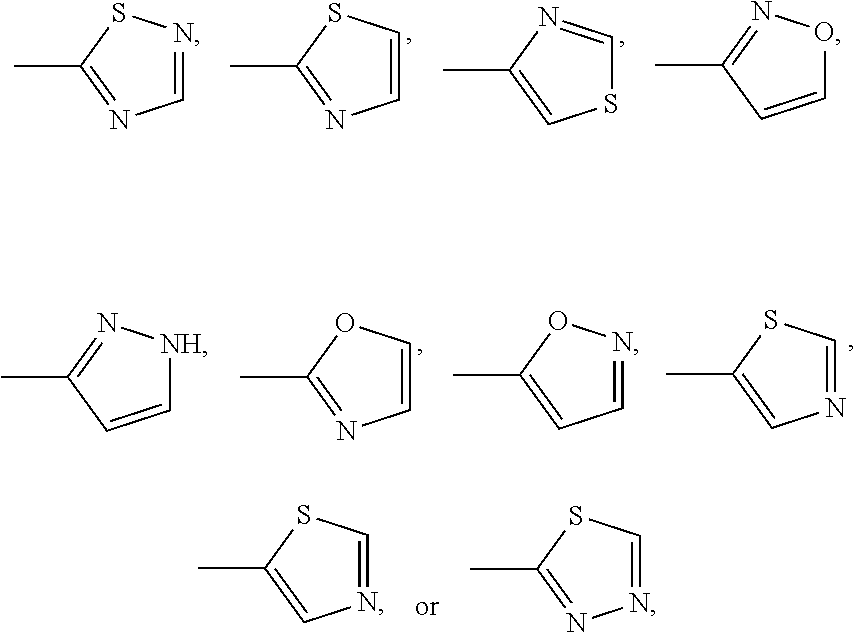Dihydrobenzoxazine and tetrahydroquinoxaline sodium channel inhibitors
a sodium channel inhibitor and dihydrobenzoxazine technology, applied in the direction of biocide, heterocyclic compound active ingredients, drug compositions, etc., can solve the problems of deteriorating one's quality of life, limited dose and use, and non-selective sodium channel inhibitors
- Summary
- Abstract
- Description
- Claims
- Application Information
AI Technical Summary
Benefits of technology
Problems solved by technology
Method used
Image
Examples
example 1 (
INTERMEDIATE D)
4-(2-BROMO-4-(TRIFLUOROMETHYL)PHENYL)-N-(1,2,4-THIADIAZOL-5-YL)-3,4-DIHYDRO-2H-BENZO[B][1,4]OXAZINE-7-SULFONAMIDE
[0476]
[0477]EXAMPLE 1 was synthesized as described for INTERMEDIATE D. 1H NMR (400 MHz, DMSO-d6) δ ppm 3.43-3.52 (m, 2H) 4.31-4.42 (m, 2H) 6.25 (d, J=8.51 Hz, 1H) 7.12-7.16 (m, 1H) 7.17 (d, J=2.15 Hz, 1H) 7.74 (d, J=7.73 Hz, 1H) 7.90 (dd, J=8.26, 1.61 Hz, 1H) 8.20 (d, J=1.86 Hz, 1H) 8.42 (s, 1H). m / z (ESI) 520.9 (M+H)+.
example 2
4-(2-CHLORO-4-(TRIFLUOROMETHYL)PHENYL)-N-(1,2,4-THIADIAZOL-5-YL)-3,4-DIHYDRO-2H-BENZO[B][1,4]OXAZINE-7-SULFONAMIDE
[0478]
[0479]A round bottom flask was charged with N-(2,4-dimethoxybenzyl)-1,2,4-thiadiazol-5-amine (0.566 g, 2.253 mmol) and THF (9.01 mL), and the flask was cooled to −78° C. LiHMDS (1.0 M in THF) (2.253 mL, 2.253 mmol) was then added, dropwise, over 1 minute. The solution was stirred for 5 minutes, and a solution of Intermediate E (0.743 g, 1.802 mmol) in THF (1.060 mL, 1.802 mmol) was added dropwise over 1 minute. The bath was removed, and the resulting mixture was stirred for 30 minutes. The reaction was diluted with sat. aq. NH4Cl (30 mL), and was washed with ethyl acetate (3×20 mL). The organic layers were combined, dried over magnesium sulfate, filtered and concentrated to yield 1.14 g of a light orange oily solid. The material was passed through a 10 g SCX column to provide 4-(2-chloro-4-(trifluoromethyl)phenyl)-N-(2,4-dimethoxybenzyl)-N-(1,2,4-thiadiazol-5-yl)-3...
example 3
4-(2-(1-METHYL-1H-PYRAZOL-5-YL)-4-(TRIFLUOROMETHYL)PHENYL)-N-(1,2,4-THIADIAZOL-5-YL)-3,4-DIHYDRO-2H-BENZO[B][1,4]OXAZINE-7-SULFONAMIDE
[0480]
[0481]A microwave vial was charged with INTERMEDIATE D (0.100 g, 0.192 mmol), 1-methyl-5-(4,4,5,5-tetramethyl-1,3,2-dioxaborolan-2-yl)-1H-pyrazole (Sigma Aldrich, St. Louis, Mo., 0.060 g, 0.288 mmol), tetrakis(triphenylphosphine)palladium(0) (0.022 g, 0.019 mmol), and K2CO3 (0.133 g, 0.959 mmol). The solids were diluted with dioxane (1.279 mL) and water (0.639 mL), and the reaction was heated under microwave irradiation at 100° C. for 60 minutes (starting material remained, but the reaction was moved forward). The reaction mixture was diluted with water, and washed with DCM. Equal partitioning between both layers was observed, so the organic and aqueous layers were combined and concentrated. The material was taken up in methanol, and acidified with HCl (1N) (3.84 mL, 3.84 mmol), and then re-concentrated under a vacuum. The solids were taken up i...
PUM
| Property | Measurement | Unit |
|---|---|---|
| Current | aaaaa | aaaaa |
Abstract
Description
Claims
Application Information
 Login to View More
Login to View More - R&D
- Intellectual Property
- Life Sciences
- Materials
- Tech Scout
- Unparalleled Data Quality
- Higher Quality Content
- 60% Fewer Hallucinations
Browse by: Latest US Patents, China's latest patents, Technical Efficacy Thesaurus, Application Domain, Technology Topic, Popular Technical Reports.
© 2025 PatSnap. All rights reserved.Legal|Privacy policy|Modern Slavery Act Transparency Statement|Sitemap|About US| Contact US: help@patsnap.com



